Excitation Wavelength and Colloids Concentration-Dependent Nonlinear Optical Properties of Silver Nanoparticles Synthesized by Laser Ablation
Abstract
:1. Introduction
2. Material and Methods
2.1. Laser Ablation Setup
2.2. Z-Scan Setup
3. Results and Discussions
3.1. Characterization of AgNPs Colloids
3.2. Open Aperture Z-Scan
3.3. Closed Aperture Z-Scan
3.4. Effect of Concentration on NLO Properties of AgNP Colloids
3.5. Three-Photon Absorption Cross-Section
4. Conclusions
Author Contributions
Funding
Data Availability Statement
Conflicts of Interest
References
- Terashima, K.; Tamura, S.; Kim, S.-H.; Yoko, T. Structure and Nonlinear Optical Properties of Lanthanide Borate Glasses. J. Am. Ceram. Soc. 1997, 80, 2903–2909. [Google Scholar] [CrossRef]
- Boyd, R.; Masters, B. Nonlinear Optics, 3rd ed.; Academic: New York, NY, USA, 2008. [Google Scholar]
- Shen, Y.-R. The Principles of Nonlinear Optics, 3rd ed.; Wiley-Interscience: Hoboken, NJ, USA, 2002. [Google Scholar]
- Agrawal, G.P. Nonlinear Fiber Optics, 4th ed.; Academic Press: Cambridge, MA, USA, 2006. [Google Scholar]
- Elim, H.I.; Yang, J.; Lee, J.Y.; Mi, J.; Ji, W. Observation of saturable and reverse-saturable absorption at longitudinal surface plasmon resonance in gold nanorods. Appl. Phys. Lett. 2006, 88, 083107. [Google Scholar] [CrossRef]
- Karthikeyan, B.; Anija, M.; Philip, R. In situ synthesis and nonlinear optical properties of Au:Ag nanocomposite polymer films. Appl. Phys. Lett. 2006, 88, 053104. [Google Scholar] [CrossRef]
- Wu, D.; Liu, X.; Liu, L.; Qian, W. Third-order nonlinear optical properties of gold nanoshells in aqueous solution. Appl. Phys. A 2008, 92, 279–282. [Google Scholar] [CrossRef]
- Polavarapu, L.; Xu, Q.-H. A single-step synthesis of gold nanochains using an amino acid as a capping agent and characterization of their optical properties. Nanotechnology 2008, 19, 075601. [Google Scholar] [CrossRef]
- Seo, J.T.; Yang, Q.; Kim, W.-J.; Heo, J.; Ma, S.-M.; Austin, J.; Yun, W.S.; Jung, S.S.; Han, S.W.H.; Tabibi, B.; et al. Optical nonlinearities of Au nanoparticles and Au/Ag coreshells. Opt. Lett. 2009, 34, 307–309. [Google Scholar] [CrossRef]
- Lee, Y.H.; Yan, Y.; Polavarapu, L.; Xu, Q.-H. Nonlinear optical switching behavior of Au nanocubes and nano-octahedra investigated by femtosecond Z-scan measurements. Appl. Phys. Lett. 2009, 95, 023105. [Google Scholar] [CrossRef]
- Philip, R.; Kumar, G.R.; Sandhyarani, N.; Pradeep, T. Picosecond optical nonlinearity in monolayer-protected gold, silver, and gold-silver alloy nanoclusters. Phys. Rev. B 2000, 62, 13160–13166. [Google Scholar] [CrossRef] [Green Version]
- Gurudas, U.; Brooks, E.; Bubb, D.M.; Heiroth, S.; Lippert, T.; Wokaun, A. Saturable and reverse saturable absorption in silver nanodots at 532 nm using picosecond laser pulses. J. Appl. Phys. 2008, 104, 073107. [Google Scholar] [CrossRef]
- Zheng, C.; Du, Y.; Feng, M.; Zhan, H. Shape dependence of nonlinear optical behaviors of nanostructured silver and their silica gel glass composites. Appl. Phys. Lett. 2008, 93, 143108. [Google Scholar] [CrossRef]
- Jiang, J.; Wang, J.; Wu, T.; Gao, Y. Nonlinear Absorption and Ultrafast Dynamics of Ag Nanoparticle. Photonics 2021, 8, 233. [Google Scholar] [CrossRef]
- Ara, M.M.; Javadi, Z.; Sirohi, R. Measurement of nonlinear refractive index of Ag and Au nano-particles using moiré technique. Optik 2011, 122, 1961–1964. [Google Scholar] [CrossRef]
- A Ganeev, R.; I Ryasnyansky, A.; Kamalov, S.R.; Kodirov, M.K.; Usmanov, T. Nonlinear susceptibilities, absorption coefficients and refractive indices of colloidal metals. J. Phys. D Appl. Phys. 2001, 34, 1602–1611. [Google Scholar] [CrossRef]
- Williams, W.E.; Soileau, M.; Van Stryland, E.W. Optical switching and n2 measurements in CS2. Opt. Commun. 1984, 50, 256–260. [Google Scholar] [CrossRef]
- Moran, M.; She, C.-Y.; Carman, R. Interferometric measurements of the nonlinear refractive-index coefficient relative to CS2in laser-system-related materials. IEEE J. Quantum Electron. 1975, 11, 259–263. [Google Scholar] [CrossRef]
- Yan, X.-Q.; Liu, Z.-B.; Zhang, X.-L.; Zhou, W.-Y.; Tian, J.-G. Polarization dependence of Z-scan measurement: Theory and experiment. Opt. Express 2009, 17, 6397–6406. [Google Scholar] [CrossRef]
- Sheik-Bahae, M.; Said, A.; Wei, T.-H.; Hagan, D.; Van Stryland, E. Sensitive measurement of optical nonlinearities using a single beam. IEEE J. Quantum Electron. 1990, 26, 760–769. [Google Scholar] [CrossRef] [Green Version]
- Pramodini, S.; Sudhakar, Y.N.; SelvaKumar, M.; Poornesh, P. Studies on third-order optical nonlinearity and power limiting of conducting polymers using the z-scan technique for nonlinear optical applications. Laser Phys. 2014, 24, 045408. [Google Scholar] [CrossRef]
- Rad, A.G. Single Beam Z-Scan Measurement of Nonlinear Refractive Index of Crude Oils. J. Mod. Phys. 2014, 5, 280–284. [Google Scholar] [CrossRef] [Green Version]
- Konda, S.R.; Maurya, S.K.; Ganeev, R.A.; Lai, Y.H.; Guo, C.; Li, W. Third-order nonlinear optical effects of silver nanoparticles and third harmonic generation from their plasma plumes. Optik 2021, 245, 167680. [Google Scholar] [CrossRef]
- Zhang, X.; He, T.; Wang, C.; Zhang, J. Nonlinear-Optical and Fluorescent Properties of Ag Aqueous Colloid Prepared by Silver Nitrate Reduction. J. Nanomater. 2010, 2010, 129067. [Google Scholar] [CrossRef] [Green Version]
- Rativa, D.; De Araujo, R.E.; Gomes, A.S.L. One photon nonresonant high-order nonlinear optical properties of silver nanoparticles in aqueous solution. Opt. Express 2008, 16, 19244–19252. [Google Scholar] [CrossRef] [PubMed]
- Neddersen, J.; Chumanov, G.; Cotton, T.M. Laser Ablation of Metals: A New Method for Preparing SERS Active Colloids. Appl. Spectrosc. 1993, 47, 1959–1964. [Google Scholar] [CrossRef]
- Mafuné, F.; Kohno, J.-Y.; Takeda, Y.; Kondow, T. Formation of Stable Platinum Nanoparticles by Laser Ablation in Water. J. Phys. Chem. B 2003, 107, 4218–4223. [Google Scholar] [CrossRef]
- Tsuji, T.; Jryo, K.; Nishimura, Y.; Tsuj, M. Preparation Of metal colloids by a laser ablation technique in solution: Influence of laser wavelength on the ablation efficiency (II). J. Photochem. Photobiol. A 2001, 145, 201. [Google Scholar] [CrossRef]
- Batani, D.; Vinci, T.; Bleiner, D. Laser-ablation and induced nanoparticle synthesis. Laser Part. Beams 2013, 32, 1–7. [Google Scholar] [CrossRef] [Green Version]
- Samir, A.; El-Salam, H.M.A.; Harun, S.W.; Mohamed, T. The effects of different parameters and interaction angles of a 532 nm pulsed Nd: YAG laser on the properties of laser-ablated silver nanoparticles. Opt. Commun. 2021, 501, 127366. [Google Scholar] [CrossRef]
- Ahmed, H.; Mahmoud, A.; Mobarak, M.; El-Salam, H.M.A.; Mohamed, T. Using femtosecond laser pulses to study the nonlinear optical properties of rhodamine 6G dissolved in water. J. Mol. Liq. 2021, 340, 117199. [Google Scholar] [CrossRef]
- Mulvaney, P. Surface Plasmon Spectroscopy of Nanosized Metal Particles. Langmuir 1996, 12, 788–800. [Google Scholar] [CrossRef]
- Sastry, M.; Patil, V.; Sainkar, S.R. Electrostatically Controlled Diffusion of Carboxylic Acid Derivatized Silver Colloidal Particles in Thermally Evaporated Fatty Amine Films. J. Phys. Chem. B 1998, 102, 1404–1410. [Google Scholar] [CrossRef]
- Henglein, A. Physicochemical properties of small metal particles in solution: “Microelectrode” reactions, chemisorption, composite metal particles, and the atom-to-metal transition. J. Phys. Chem. 1993, 97, 5457–5471. [Google Scholar] [CrossRef]
- Isa, S.Z.M.; Zainon, R.; Tamal, M. State of the Art in Gold Nanoparticle Synthesisation via Pulsed Laser Ablation in Liquid and Its Characterisation for Molecular Imaging: A Review. Materials 2022, 15, 875. [Google Scholar] [CrossRef]
- Tauc, J.; Grigorovici, R.; Vancu, A. Optical Properties and Electronic Structure of Amorphous germanium. Phys. Status Solidi B 1966, 15, 627–637. [Google Scholar] [CrossRef]
- Mamdouh, S.; Mahmoud, A.; Samir, A.; Mobarak, M.; Mohamed, T. Using femtosecond laser pulses to investigate the nonlinear optical properties of silver nanoparticles colloids in distilled water synthesized by laser ablation. Phys. B Condens. Matter 2022, 631, 413727. [Google Scholar] [CrossRef]
- Henari, F.Z.; Manaa, H. Nonlinear Optical Properties, Optical Limiting and Optical Switching of Ag Nanoparticles Prepared by a Green Synthetic Method. Opt. Photon-J. 2018, 8, 235–246. [Google Scholar] [CrossRef] [Green Version]
- Zheng, C.; Ye, X.Y.; Cai, S.G.; Wang, M.J.; Xiao, X.Q. Observation of nonlinear saturable and reverse-saturable absorption in silver nanowires and their silica gel glass composite. Appl. Phys. A 2010, 101, 835–840. [Google Scholar] [CrossRef]
- Hassan, T.; Shehata, A.; Tawfik, W.Z. Cobalt Enhanced Nonlinear Optical Properties and Optical Limiting of Zinc Oxide Irradiated by Femtosecond Laser Pulses. Opt. Mater. Express 2020, 37, A1–A8. [Google Scholar] [CrossRef]
- Tian, X.; Wei, R.; Yang, D.; Qiu, J. Paradoxical combination of saturable absorption and reverse-saturable absorption in plasmon semiconductor nanocrystals. Nanoscale Adv. 2020, 2, 1676–1684. [Google Scholar] [CrossRef] [Green Version]
- Sheik-Bahae, M.; Said, A.A.; van Stryland, E.W. High-sensitivity, single-beam n 2 measurements. Opt. Lett. 1989, 14, 955–957. [Google Scholar] [CrossRef] [Green Version]
- Wang, J.; Shao, Y.; Chen, C.; Wu, W.; Kong, D.; Gao, Y. Wavelength-Dependent Optical Nonlinear Absorption of Au-Ag Nanoparticles. Appl. Sci. 2021, 11, 3072. [Google Scholar] [CrossRef]
- Mao, Z.; Qiao, L.; He, F.; Liao, Y.; Wang, C.; Cheng, Y. Thermal-induced nonlinear optical characteristics of ethanol solution doped with silver nanoparticles. Chin. Opt. Lett. 2009, 7, 949–952. [Google Scholar] [CrossRef]
- Gnoli, A.; Razzari, L.; Righini, M. Z-scan measurements using high repetition rate lasers: How to manage thermal effects. Opt. Express 2005, 13, 7976–7981. [Google Scholar] [CrossRef] [PubMed]
- Falconieri, M. Thermo-optical effects in Z -scan measurements using high-repetition-rate lasers. J. Opt. A Pure Appl. Opt. 1999, 1, 662–667. [Google Scholar] [CrossRef]
- Shehata, A.; Mohamed, T. Method for an accurate measurement of nonlinear refractive index in the case of high-repetition-rate femtosecond laser pulses. J. Opt. Soc. Am. B 2019, 36, 1246–1251. [Google Scholar] [CrossRef]
- Kwak, C.H.; Lee, Y.L.; Kim, S.G. Analysis of asymmetric Z-scan measurement for large optical nonlinearities in an amorphous As_2S_3 thin film. J. Opt. Soc. Am. B 1999, 16, 600–604. [Google Scholar] [CrossRef]
- Severiano-Carrillo, I.; Alvarado-Méndez, E.; Trejo-Durán, M.; Méndez-Otero, M. Improved Z-scan adjustment to thermal nonlinearities by including nonlinear absorption. Opt. Commun. 2017, 397, 140–146. [Google Scholar] [CrossRef]
- Fan, G.; Qu, S.; Wang, Q.; Zhao, C.; Zhang, L.; Li, Z. Pd nanoparticles formation by femtosecond laser irradiation and the nonlinear optical properties at 532 nm using nanosecond laser pulses. J. Appl. Phys. 2011, 109, 023102. [Google Scholar] [CrossRef]
- Alesenkov, A.; Pilipavicius, J.; Beganskiene, A.; Sirutkaitis, R.; Sirutkaitis, V. Nonlinear properties of silver nanoparticles explored by a femtosecond Z-scan technique. Lith. J. Phys. 2015, 55, 100–109. [Google Scholar] [CrossRef] [Green Version]
- Sudheesh, P.; Narendran, N.S.; Chandrasekharan, K. Third-order nonlinear optical responses in derivatives of phenylhydrazone by Z-scan and optical limiting studies-influence of noble metal nanoparticles. Opt. Mater. 2013, 36, 304–309. [Google Scholar] [CrossRef]
- Shahriari, E.; Yunus, W.M.M.; Naghavi, K.; Talib, Z. Effect of concentration and particle size on nonlinearity of Au nano-fluid prepared by γ (60Co) radiation. Opt. Commun. 2010, 283, 1929–1932. [Google Scholar] [CrossRef]
- Liu, J.; Mao, Y.; Huang, M.; Gu, Y.; Zhang, W. Three-Photon Absorption Cross-Section Enhancement in Two Symmetrical Fluorene-Based Molecules. J. Phys. Chem. A 2007, 111, 9013–9018. [Google Scholar] [CrossRef] [PubMed]
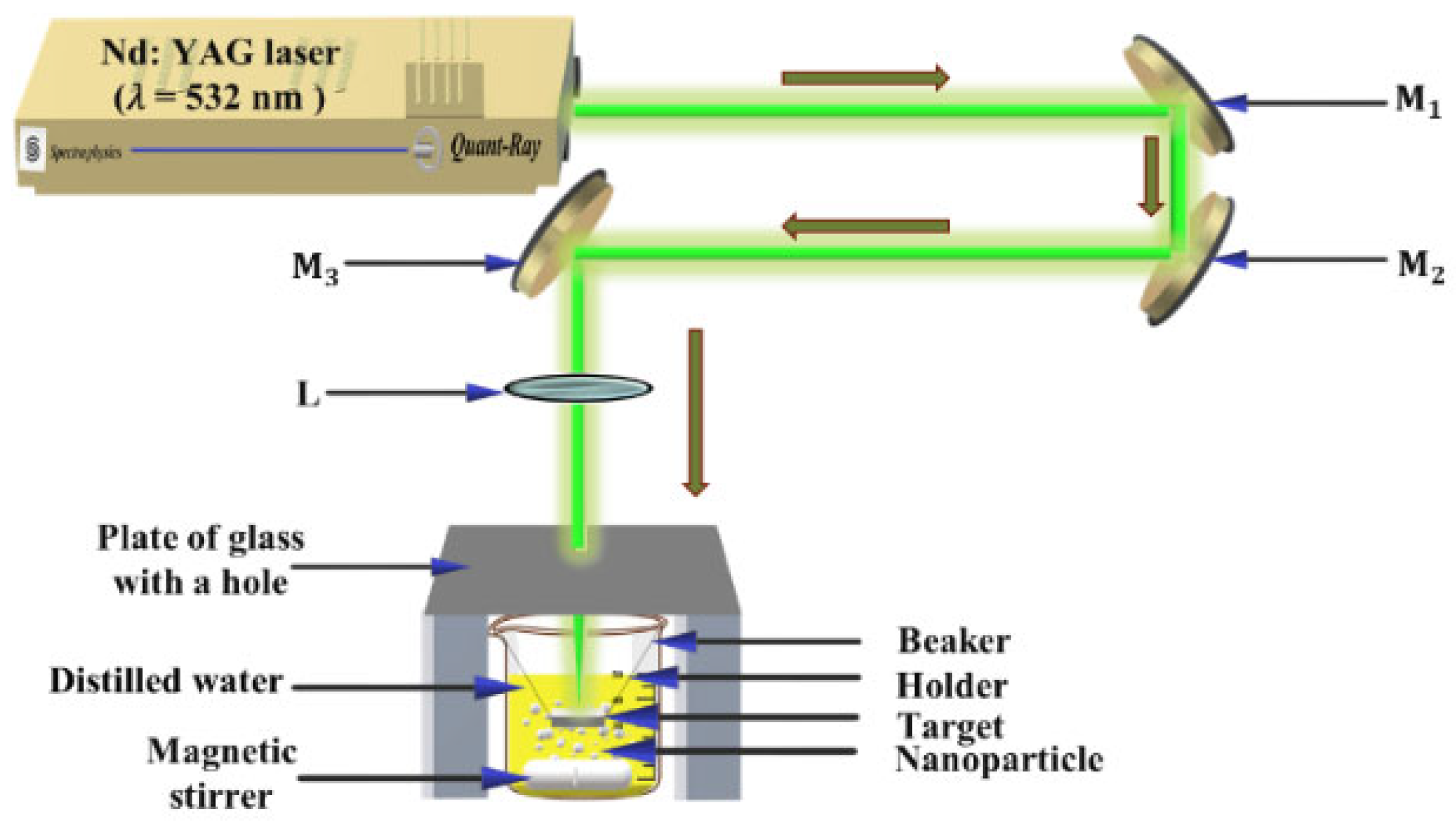

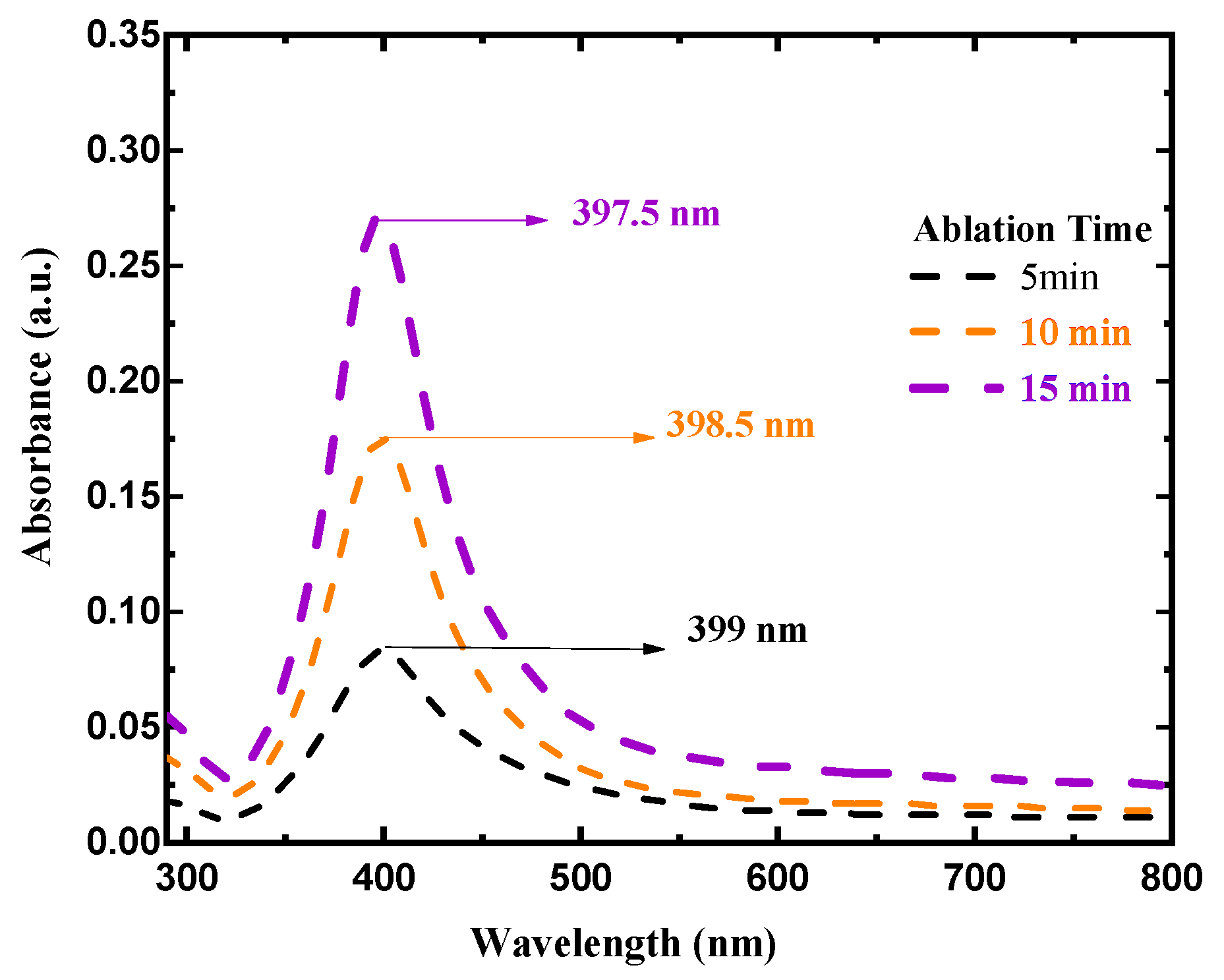
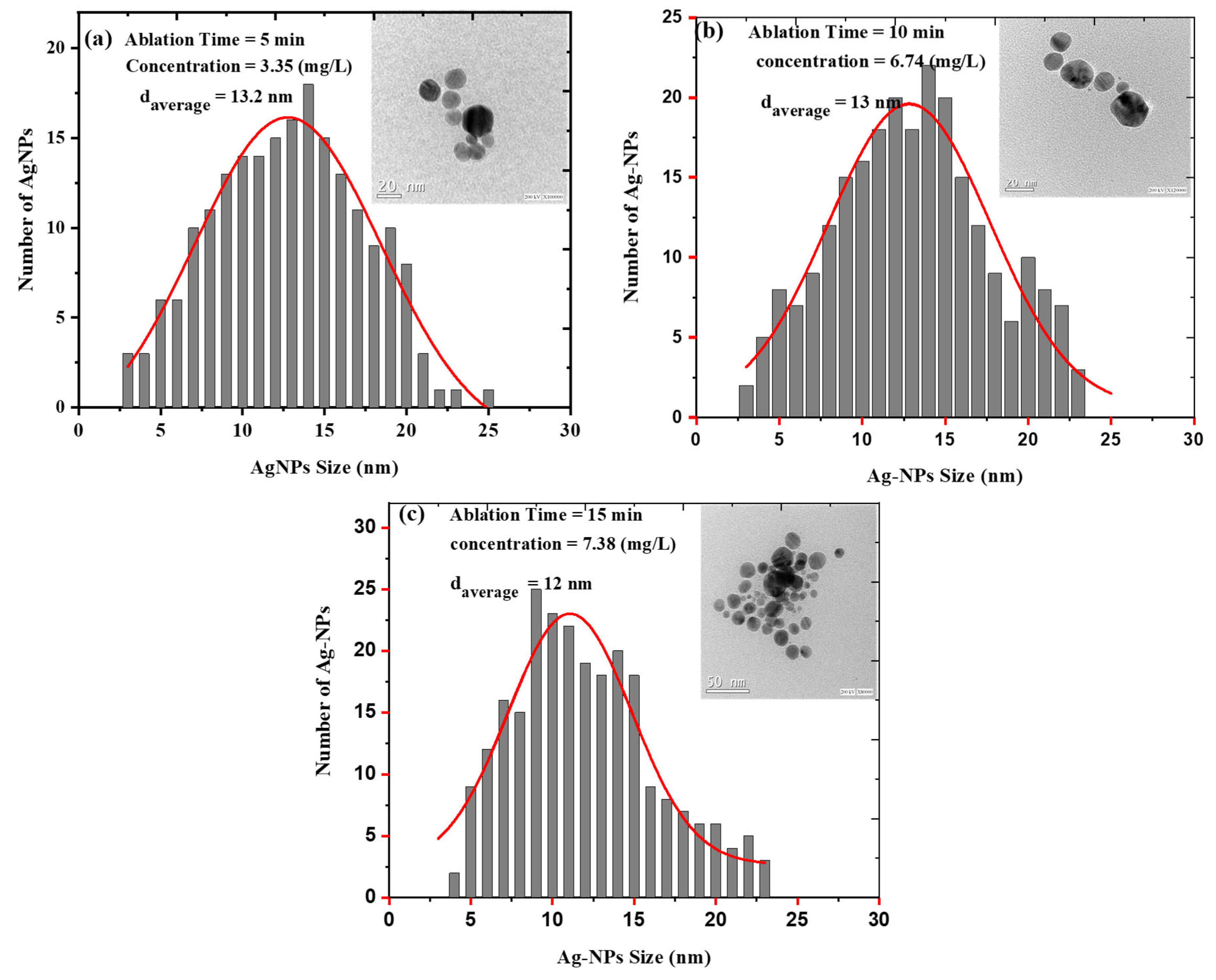

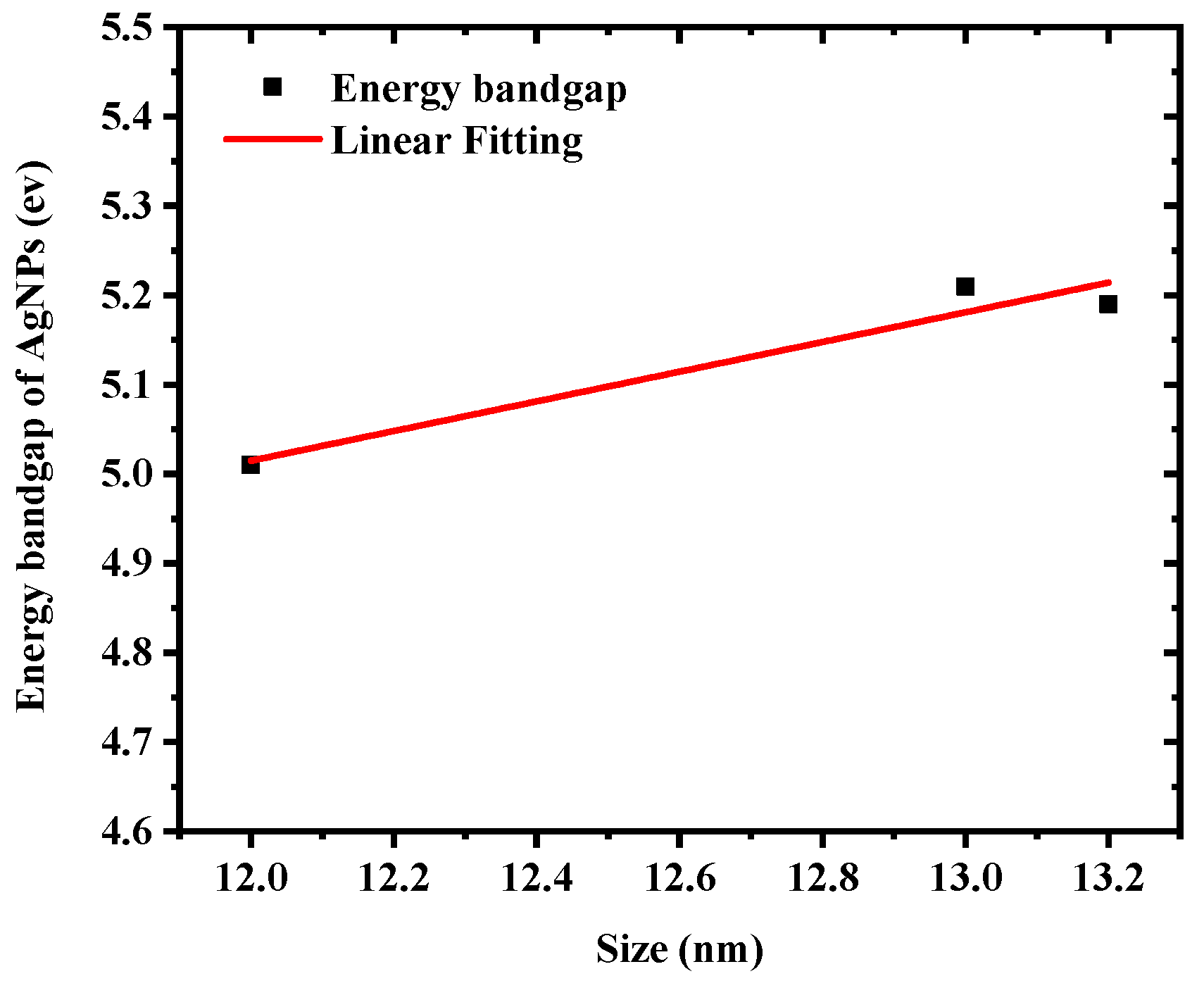
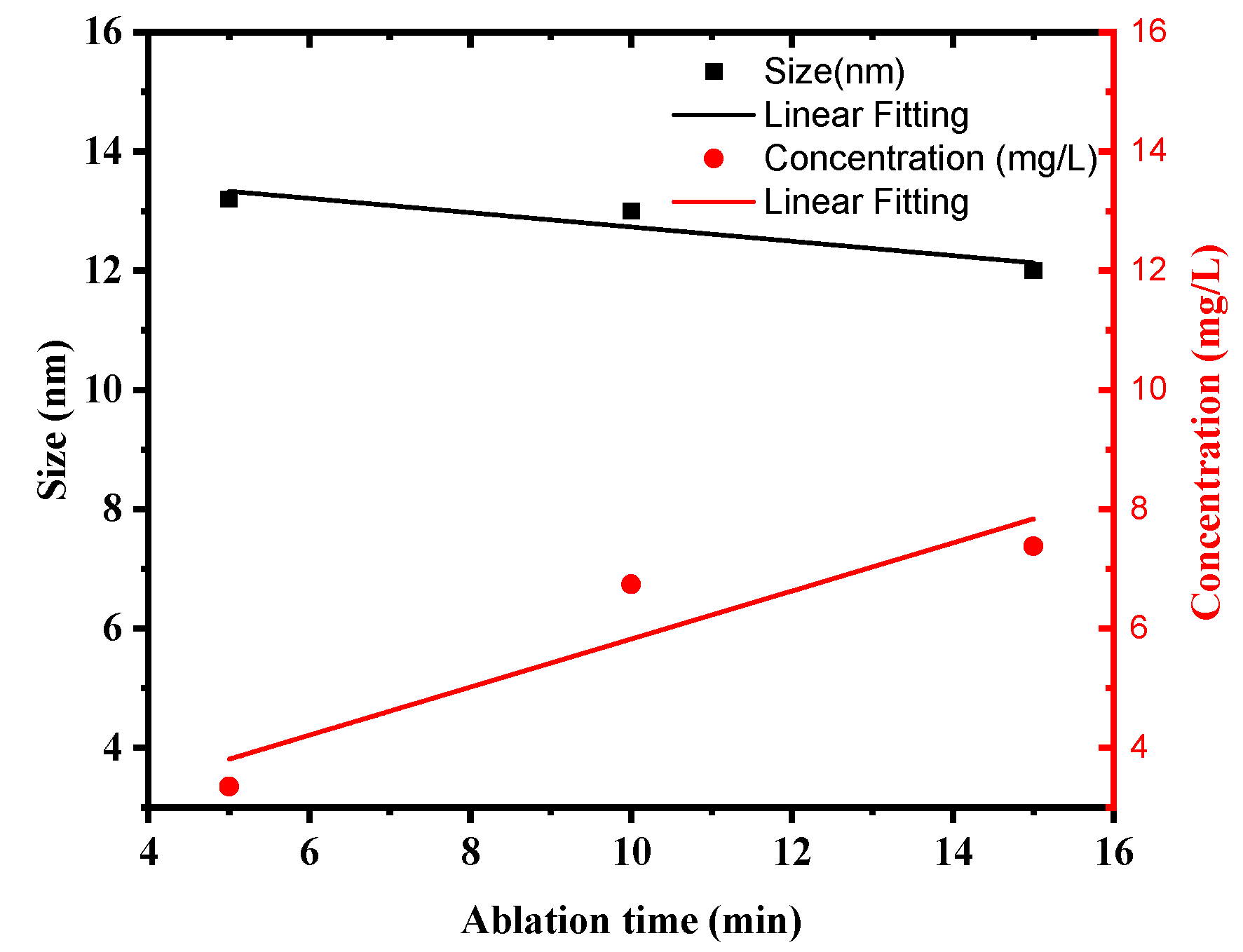
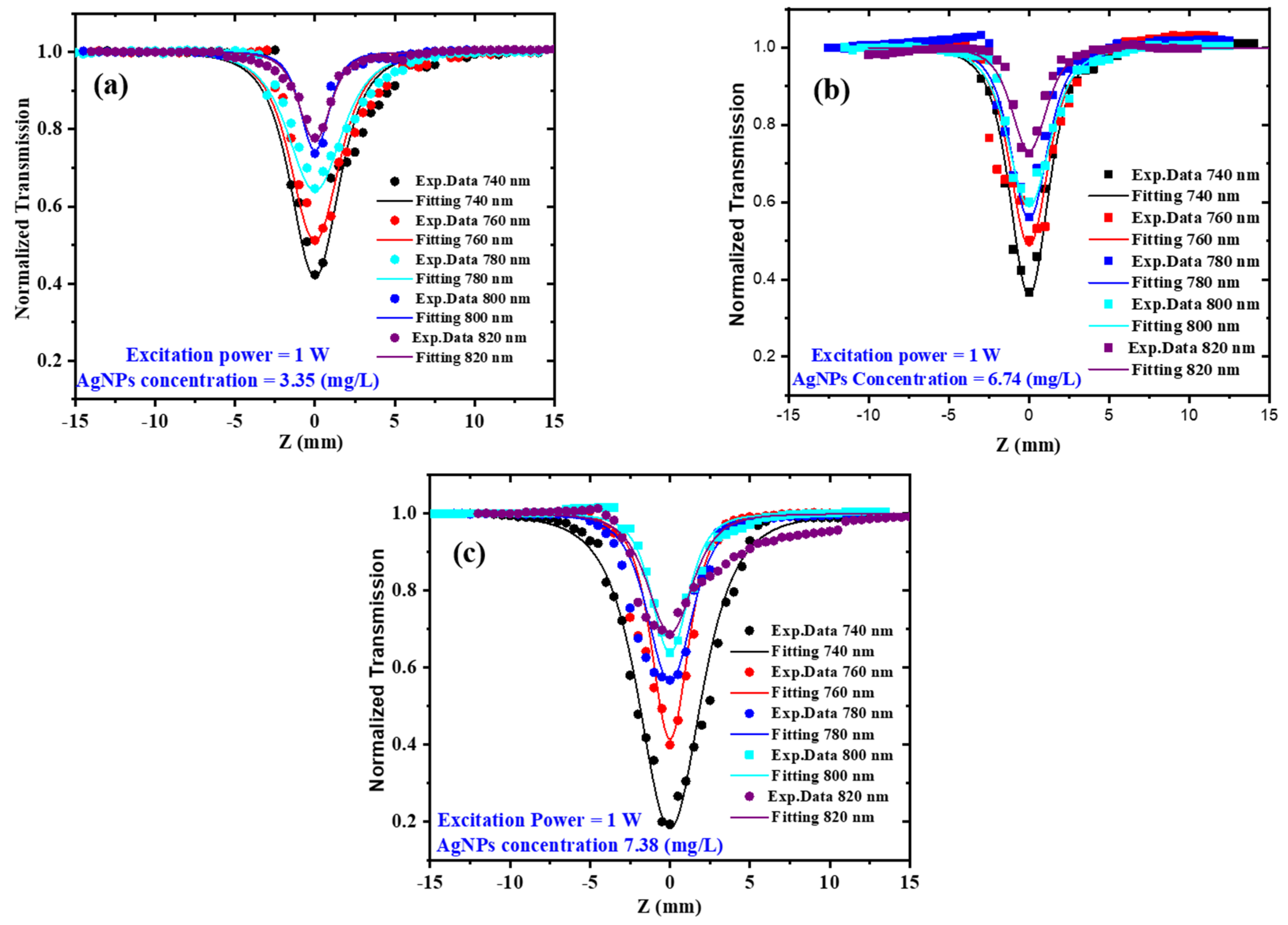
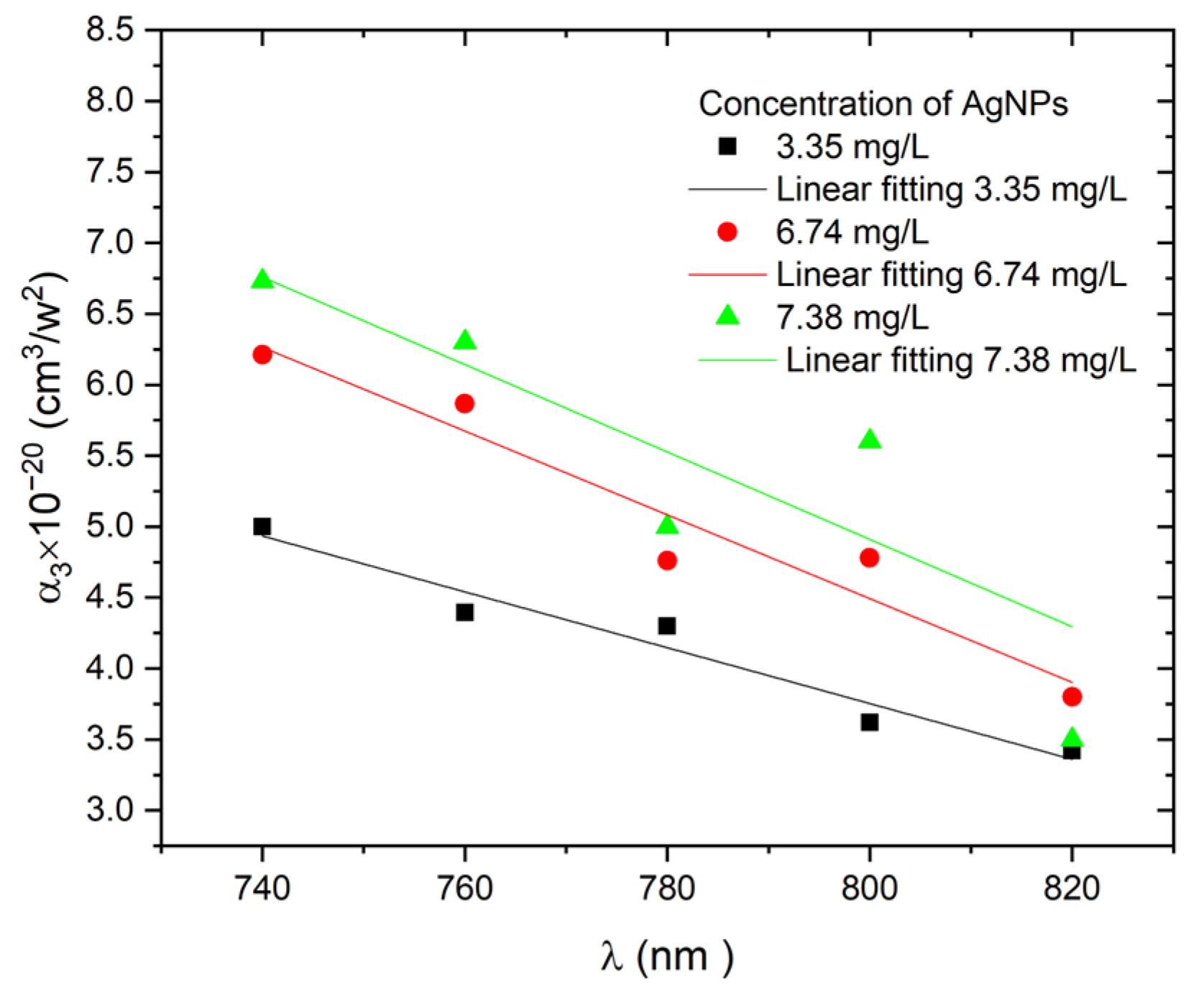

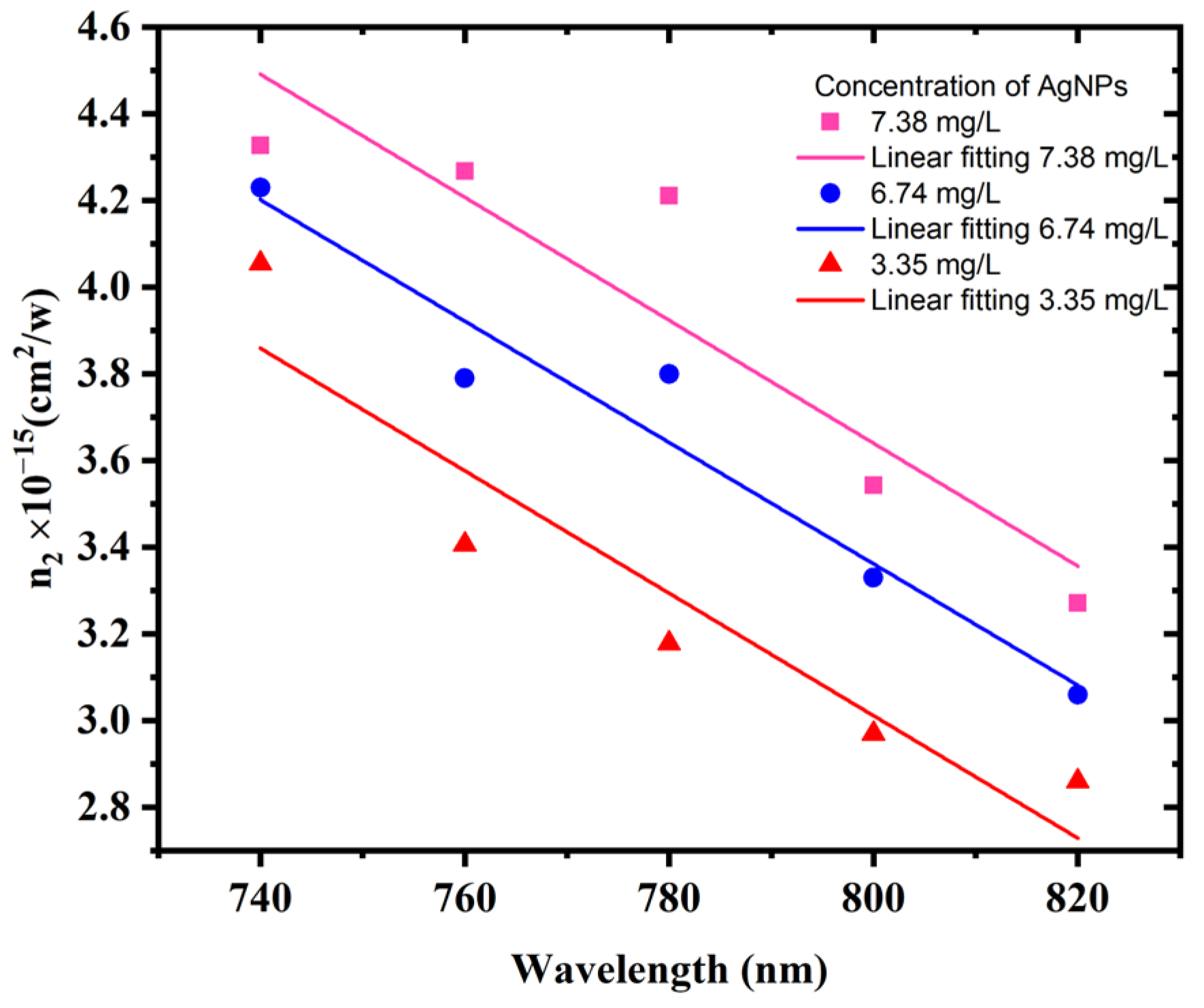
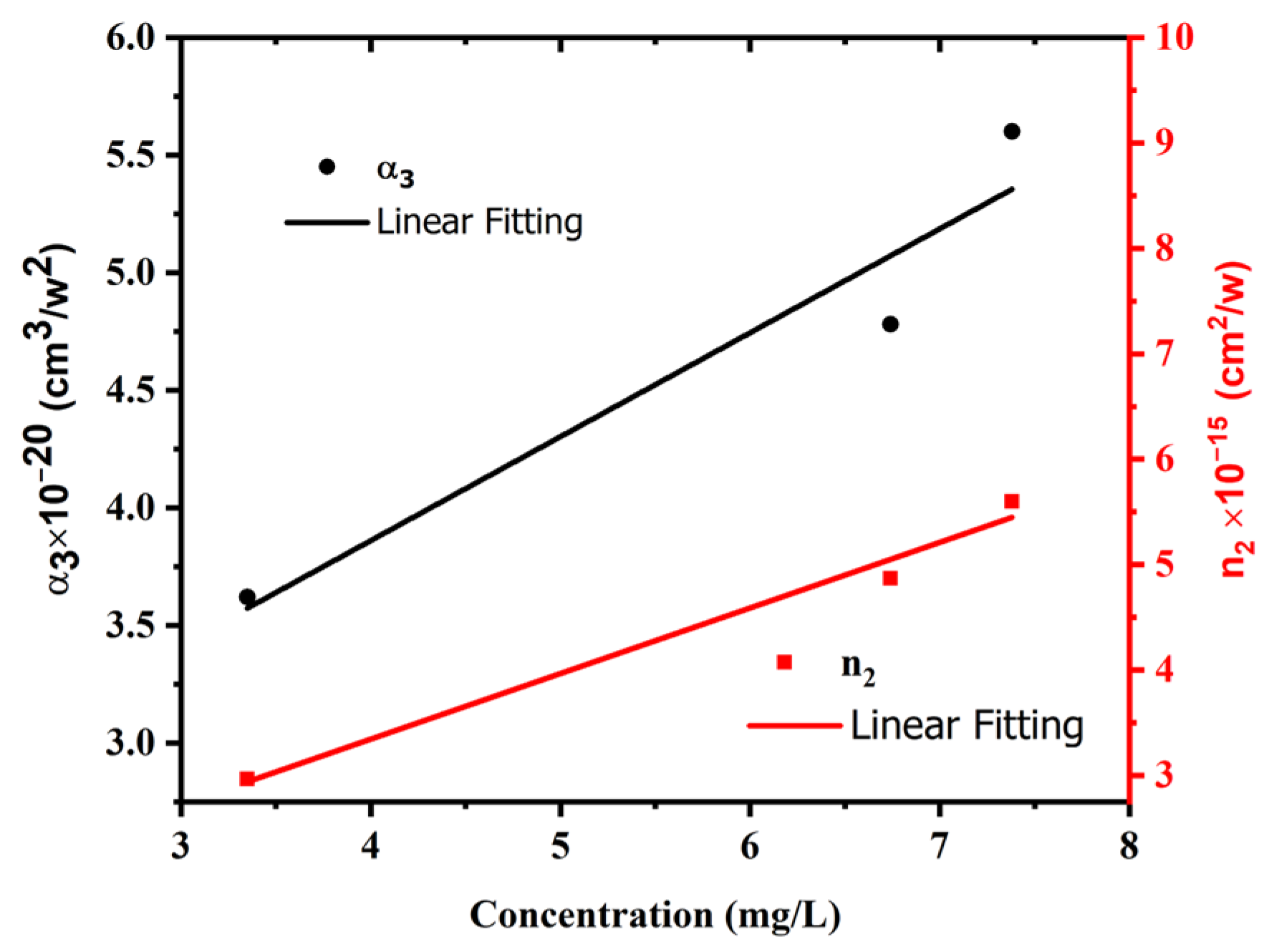
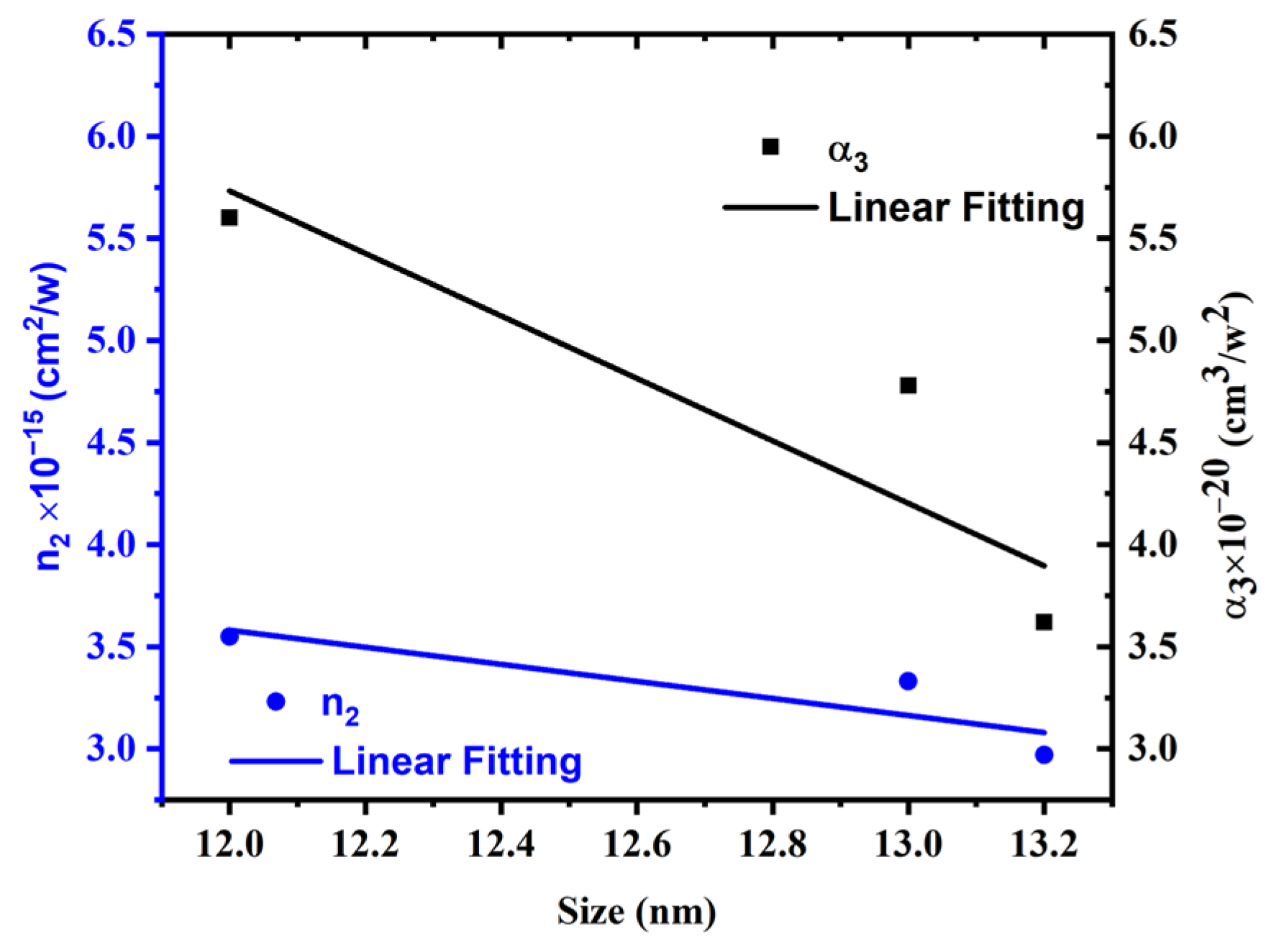
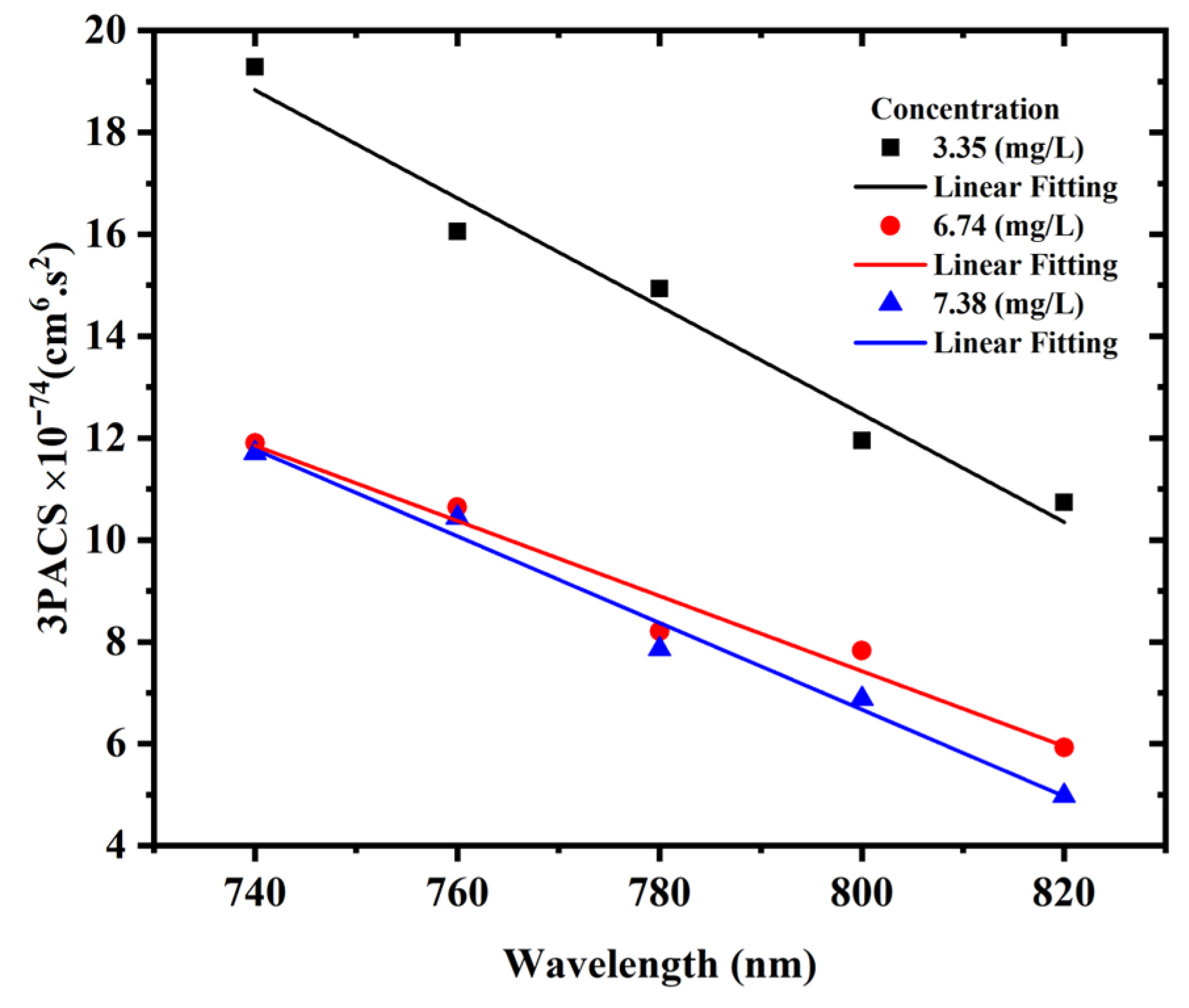
Publisher’s Note: MDPI stays neutral with regard to jurisdictional claims in published maps and institutional affiliations. |
© 2022 by the authors. Licensee MDPI, Basel, Switzerland. This article is an open access article distributed under the terms and conditions of the Creative Commons Attribution (CC BY) license (https://creativecommons.org/licenses/by/4.0/).
Share and Cite
Mohamed, T.; El-Motlak, M.H.; Mamdouh, S.; Ashour, M.; Ahmed, H.; Qayyum, H.; Mahmoud, A. Excitation Wavelength and Colloids Concentration-Dependent Nonlinear Optical Properties of Silver Nanoparticles Synthesized by Laser Ablation. Materials 2022, 15, 7348. https://doi.org/10.3390/ma15207348
Mohamed T, El-Motlak MH, Mamdouh S, Ashour M, Ahmed H, Qayyum H, Mahmoud A. Excitation Wavelength and Colloids Concentration-Dependent Nonlinear Optical Properties of Silver Nanoparticles Synthesized by Laser Ablation. Materials. 2022; 15(20):7348. https://doi.org/10.3390/ma15207348
Chicago/Turabian StyleMohamed, Tarek, Majed H. El-Motlak, Samar Mamdouh, Mohamed Ashour, Hanan Ahmed, Hamza Qayyum, and Alaa Mahmoud. 2022. "Excitation Wavelength and Colloids Concentration-Dependent Nonlinear Optical Properties of Silver Nanoparticles Synthesized by Laser Ablation" Materials 15, no. 20: 7348. https://doi.org/10.3390/ma15207348
APA StyleMohamed, T., El-Motlak, M. H., Mamdouh, S., Ashour, M., Ahmed, H., Qayyum, H., & Mahmoud, A. (2022). Excitation Wavelength and Colloids Concentration-Dependent Nonlinear Optical Properties of Silver Nanoparticles Synthesized by Laser Ablation. Materials, 15(20), 7348. https://doi.org/10.3390/ma15207348









